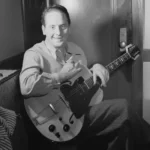
Les Paul – Guitarist and Luthier
Les Paul is widely regarded as one of the most influential guitarists in history. He was a pioneer in both the music industry and the technology of recording music. He was a talented musician, inventor, and innovator, and his contributions to the world of music have been immeasurable.
Les Paul was the first to use a system called multiple recording dubbing, and he is also considered the inventor of the eight-track machine; these technical gadgets can no longer be ignored in the studio these days.
Table of Contents
Early Years
Les Paul was born on June 9, 1915, in Waukesha, Wisconsin as Lester William Polsfuss. His birthplace Waukesha, was located on a railroad track. When Les, a 10-year-old boy, was listening to the trains in his bedroom one morning, he noticed that the windows began to shake as the sound reached a certain pitch.
Curious about this phenomenon as Les was, he held his hand to the glass and discovered that he could dampen the vibrations but could not stop. Only when the speed of the train and thus also the noise changed, did the window shaking stop. The next day he asked the physics teacher, Mr. Kahn, how this could be explained.
“That is called resonance. Your window hears the train, as your eardrum hears me right now. That’s how music is made.”
Mr. Kahn explained.
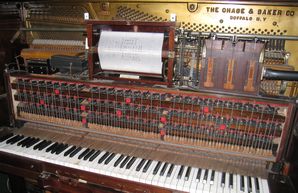
Les always wanted to explore everything.
“What are you doing?” his mother asked when she saw that Les saw new holes in the role of the pianola.
“I’m making him better,” Les replied.
Because of the extra holes, the pianola turned out to sound like two pianolas. Les was clearly musically gifted.
When he received a harmonica on his ninth birthday, he was able to play it after a few hours. After that, he bought a guitar from his savings and soon got to grips with the basic chords. Singing and alternating with his harmonica, he formed a one-man band and called himself ‘Red Hot Red,’ because of his hair color. At that time, Les occasionally played in a drive-in restaurant where one day a waitress told him that the customers were complaining.
“They can’t hear you in the back,” she said.
Something has to be found on that, he thought. When he discovered that the telephone’s handset was vibrating, just like a radio speaker, Les took both devices to the restaurant.

He tied the telephone receiver to a broomstick and connected it to the radio with a cable. In this “microphone” he started singing. The customers even started applauding, but then complained that they could not hear the guitar properly. Les now got the idea to also amplify the guitar electrically. He took the needle of a record player and put it in the comb of his guitar. He connected the element of the needle to the amplifier of another radio that amplified the vibrations of the needle. And now he had an electric guitar!
At the age of seventeen, Les became interested in bluegrass, and country music. A guitarist named “Sunny Joe” Wolverton heard Les playing and asked Les to come and play with him in the band. Sunny Joe taught Les Paul everything he knew about the guitar.
Les Paul Trio
In the early 1930s, Les moved to Chicago and began playing in various bands. He played a variety of instruments, including guitar, harmonica, and banjo, and he quickly became known for his virtuosity and innovative playing style. In 1936, Les formed a trio with Jim Atkins (who later changed his name to Chet Atkins) and Ernie Newton. The trio became known as the Les Paul Trio, and they played together for several years. Les played under the pseudo-Rhubarb Red, country music. Every night before Les went to bed, he first cleaned his guitar and set it up in his room so that if he woke up in the morning, his eyes would immediately fall on the instrument.
But the inventor in him remained active. He had already made his own record player by using the flywheel of an old Cadillac and connecting it with the drive belt of a dental drill to the engine of a jukebox.
Les was a ‘night owl,’ and thought it was a pity that in the wee hours, there was no one to jam with him. Then he remembered what he had done at home with the pianola scrolls, and wondered if he could use his recording device to turn a gramophone into an automatic background band. He started experimenting.
Sound recordings are recorded on a plate by engraving the vibrations of a needle in a spiral groove. Les discovered that he could make a second groove between the tracks of the first, on which a different series of notes could be recorded. Both grooves could then be played simultaneously with the help of two needles. The effect was that of two guitars. He then made a second turntable and recorded alternately on one turntable, then again on the other, adding new pieces each time until the sound consisted of several layers.
But the record companies were not impressed by his inventions: “A nice trick, nothing more.”
New York Star
In the late 1930s, he moved to New York. By day he played the guitar in, and national radio program or conductor Fred Warring, and by night for Harlem’s big ones of jazz.
At that time you made a record by putting all the musicians in one room and hoping that they would play perfectly. But someone always made a mistake, and you could start again. Les was convinced that there had to be a better way.
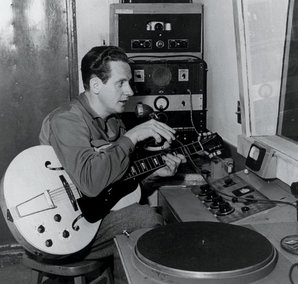
“You need your own studio,” Bing Crosby told him in 1947 when Les was playing with him in Los Angeles. So Les built his own recording studio in the garage behind the house with the most modern recording equipment at that time.
Renowned stars from that time, Andy Williams, W.C. Fields, Kay Starr, and the Crosby family, came to record in his backyard. In addition, he was able to perfect his multiple recording techniques in this studio and to make various demos.
During WW II, Les worked for the radio network of the American armed forces and made recordings that were broadcast all over the world. But no matter how hard he worked, the Germans seemed to be able to broadcast recordings just as well and often even faster. How was that possible? The answer came when Les found a device in an abandoned headquarters of the Germans.

He immediately realized what it was used for.
“Bing,” he said to Crosby, “I believe I now know how to sing on the radio, while at the same time on the golf course.”
Instead of on plates, this device made recordings on a magnetic tape that could be used over and over again and that could be easily mounted with scissors and glue.
Les now owned a large number of multi-recorded records and was determined to make them heard to the world. One day, when he was rejected by a record company again, Les’s workmen were busy fixing a sign with “Capitol Record” attached to a building. With some demos under his arm, he walked back inside, so that if someone stopped him, he could say he was on his way out. He went backward the stairs and came to the office of vice-president Jim Conkling.
“Do you want to listen to one of my records?” Les implored.
Conkling agreed.
Les put the record on the record player and while guitar runs, such as those that had not been recorded before, filled the room, Conkling listened breathlessly.
“How many of these types of records do you have?” he asked.
“A lot,” Les said. “This is the worst.”
Conkling pulled out a pen and scribbled a little on the back of an envelope.
“Signe it,” he said and gave it to Les. That contract changed the history of pop music.

“Lover,” Les Paul’s first single, was released in 1948 and was an instant hit. The song started with warm bass tones, swelled into a mix of fast guitar sounds, and introduced the world for the first time to special sound effects such as reverberation.
Just when “Lover” was released, Les drove a car that slipped off a slippery road and ended up in an abyss. The driver, a young singer named Colleen Summers, was not seriously injured, but Les broke his leg, back, the both shoulders and contracted a torn spleen. Eighteen centimeters of bone were removed from his right arm. The arm was set, but became infected, causing it to swell up to five times its normal size, and it seemed that he should be amputated.
At the age of 33 (at the top of his musical career) Les Paul was about to lose both his arm and fame. Fortunately, on the advice of a surgeon in Oklahoma, Les was transferred to Good Samaritan Hospital in Los Angeles, where his arm was broken again and screwed in such a way that his hand was pointing permanently at his navel.
“I’m a guitarist,” Les had told the doctors. “If my arm needs to be secured in one position, then please this way.”
After two years of rehabilitation, Les played the guitar again.
“The accident actually improved my technique,” he says now. “It forced me to omit unnecessary movements of the elbow.”
The accident had another unexpected consequence. He and Colleen Summers fell in love. Les thought she would be a good asset to his act.
“There is only one problem – Your name,” he said.
When Summers asked how she was to be named, Les consulted the phone book and said, “Mary Ford.”
Gibson Les Paul
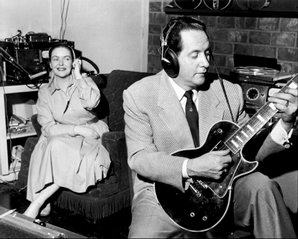
Les had been dreaming of a different kind of sound for years. Sound that could not even be taken from his electric guitar. For hours and hours, he had been listening to the sound of a single string against different backgrounds, hollow wood, solid wood, steel, aluminum. He concluded that hollow wood was less suitable for reinforcement, so he built some solid-body guitars. They produced exactly the sound he was looking for, but nobody was interested.
“There was no thought that Gene Autry, the popular country singer, was going to play on something that looked like railway sleepers!” said Les.

In 1950, the new Gibson director Ted McCarty met Les and Mary at a meeting in Pennsylvania and showed them a single cutaway-solid body guitar with a carved maple top. Les was particularly enthusiastic about it and suggested fitting his own trapezoid-shaped string holder and tailpiece on the guitar.
They worked all night on a handwritten two-page contract, which stipulated that Gibson would market the guitar with a Les string holder and tailpiece under the name Les Paul. Les would receive royalties from every copy sold and would not be obliged to play another guitar in public. This was the start of perhaps the most appreciated electric guitar in the world.
Although the Gibson Guitar Company produced a solid-body guitar in the 1950s, this guitar only became popular in the mid-1960s when pop music had taken a new direction in groups such as The Beatles, and Les Paul was honored. Today, an original Les Paul Standard solid-body guitar built by Gibson between 1958 and 1960 generates around $40,000.
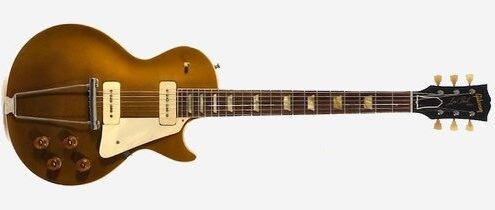
If you’re considering becoming the proud owner of a Gibson Les Paul, one of the first steps in assessing its authenticity is to use the Gibson serial number lookup tools.
Gibson SG Guitar
A damper for Les was that people from Gibson without modern knowledge or consultation, thoroughly modernized the Les Paul guitar. Due to the declining sales figures of the Les Paul guitar, the Les Paul was thoroughly innovated. The body made of mahogany wood was made thinner and the top was flattened. The neck became thinner and got a smaller heel. This new construction would save production costs.
Les was disappointed in the result, among other things, he found the strength of the body and neck bad. Also because this innovation was done outside of him, he asked Ted McCarty to dissolve his contract with Gibson and get his name from this new guitar. In 1963 the name Les Paul was removed from the guitar and now got the name SG, which stands for Solid Guitar. Despite Les’s objections, the SG became as successful as Les Paul.
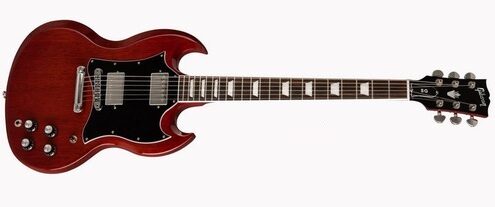
Post-Gibson Adventures
Les Paul retained the fascination for the tape recorder. With the help of others, Les thought that if he moved the heads of the device, he could record one sound over another. But his next idea was the most revolutionary.
“Instead of covering the entire width of the tire, let’s put the heads one above the other and record on multiple tracks,” he said.
This led to the development of the synchronized stereophonic band and the eight-track band to the current, advanced techniques.
The modern studios of today use 48 or more track recorders that can be recorded during different sessions. The tracks are then mixed and the result often sounds different than the original recording.
Daniel Queen, chairman of the Technical Council of the American Association of Sound Engineering, says:
“Les Paul’s multi-track concept has not only influenced the way pop music sounds, it has also influenced serious music, from the recording of a Mahler symphony to the avant-garde music of composers such as John Cage.”

Les Paul remained active in music until he died in 2009. He and Mary split up after they stopped singing, but they remained friends until she died in 1977. In the same year, Les Paul received a Grammy award for an album that he made with guitarist Chet Atkins. Subsequently, the compilation CD “Les Paul: The Legend and the Legacy,” which was released in 1992, was nominated for a Grammy award.
Paul still stayed up all night and invented at his New Jersey home, so crammed with equipment (including his mother’s wind-up gramophone that he used the needle for) that someone described the house as “half museum, half electronics -store.”
He also worked on recording equipment that would make the CD obsolete again.
“It must be possible to record without moving parts,” he said, “and play it through speakers that can reproduce any sound that our eardrum can hear.”
He performed almost every Monday night until his death at Fat Tueday’s, a jazz club in Manhattan.
Lester William Polsfuss died on August 13, 2009, in White Plains, New York State, from the complications of severe pneumonia. Les became 94 years old.
Legacy
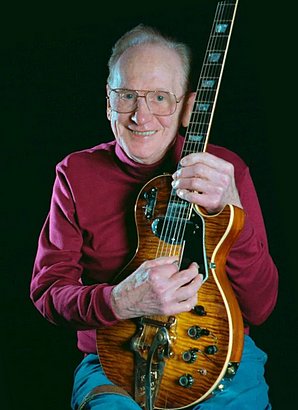
Les Paul’s contributions to the music industry and the technology of recording have been immeasurable. He was a true pioneer and innovator, and his influence can be heard in countless recordings and performances. He was inducted into the Rock and Roll Hall of Fame in 1988, and he continued to perform and record music until his death.
In addition to his musical and technological contributions, Les was also known for his showmanship and charisma. He was a regular on television and radio shows throughout the 1950s and 1960s, and he was known for his humor and wit. He also had some successful business ventures, including the development of the first eight-track tape recorder.
Les Paul was a true visionary and innovator, and his contributions to the music industry and the technology of recording have been immeasurable. He was a talented musician, inventor, and businessman, and his legacy continues to inspire and influence generations of musicians and recording engineers.
The Gibson Les Paul, his signature guitar, is still one of the most iconic and sought-after electric guitars in the world, and his recordings continue to be celebrated as some of the most innovative and groundbreaking in history. Les Paul was a true legend, and his impact on the music industry will be felt for generations to come.
Pop guitarist Steve Miller summarized the career of les Paul as follows:
In addition to the fact that Les has sold millions of records and has fascinated his fans for over sixty years, he was the first with the talent and insight to combine music and technology.
What Steve Miller and many other guitarists know is that every sound they make is the legacy of Les Paul’s talent. But almost no one can imagine that it all started with a boy, a train, and a vibrating window.
That was the day a child came into contact with music.
That was the day he heard the future.
